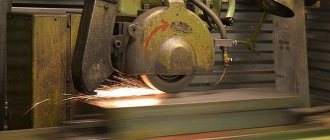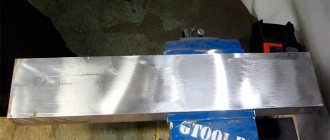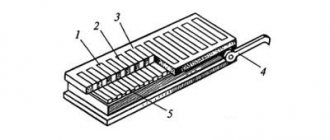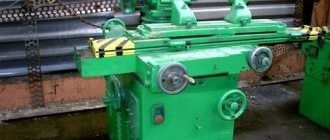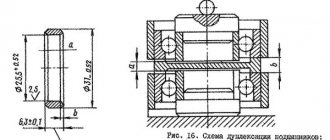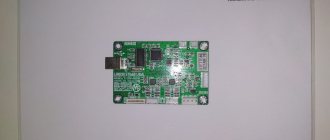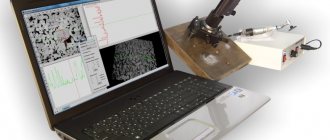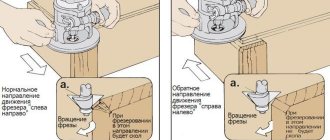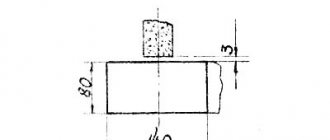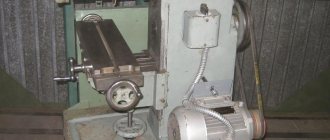Features of flat grinding
The surface of the finishing disc determines the type of grinding: end or periphery. The main characteristics of peripheral grinding methods:
- mortise grinding. it is used when working with parts where the width is not greater than the height. also in cases where the plane is limited by tubercles. During this work, the disc wears out quickly, and this requires frequent adjustments. great accuracy is not achieved during this work;
- deep type of grinding. when carrying out such an action during the period of one table stroke at a low feed speed of the longitudinal type, full allowances are removed.
- grinding using variable cross feed. it allows you to finish any volumetric areas with high quality. If the transverse feed is inconsistent during the last movements, you need to set a small feed depth. this is required to reduce the inaccuracy that the disk creates as a result of wear;
- grinding using constant cross feed. it is carried out constantly, and its value for each movement should not be higher than half the circular height. If you compare this method with the previous one, it creates a more precise finish.
All of the above methods do not lead to contact between the wheel and the part to such a high degree as when finishing with an end face. As a result, there is no need to exert great physical effort, and not as much heat is generated during operation. Although the peripheral type is inferior in productivity to end finishing.
How to make a spring with your own hands from wire and in production
Design features of the machine
The main purpose of the 3G71 machine is grinding various parts and workpieces using special abrasive wheels. The process occurs with a spindle on which the abrasive is located. Changing the position of the part can occur due to the displacement of the work table and spindle head.
Basically, machining is carried out by contacting the periphery of the wheel with the workpiece being processed. With the help of special devices it is possible to change the angle up to 90°. However, to do this, you must purchase components that are not included in the standard equipment package.
The design and operational characteristics of the machine include the following:
- the electromagnetic plate ensures a stable position of the workpiece during processing;
- independent mechanisms for moving the work table and grinding head. The kinematic diagram of the latter is based on rolling guides;
- convenient location of feed response devices. They are located at the bottom of the worktable support. The control unit for the coolant supply system is also located there.
The control components are located in a separate block, which is installed on the right side of the equipment. During operation of the 3G71 machine, access to it remains free, regardless of the operating mode and position of the work table.
When installing additional components, it will be possible to perform profile grinding of workpieces. However, before this, it is necessary to agree on the dimensions and mounting locations of the device.
Specifications
Main characteristics of the IT-1M lathe:
- The maximum diameter of the workpiece depends on the location: directly above the bed - 400, above the recess - 550, above the support - 225.
- In the recess, the maximum processing length is 30 cm.
- The diameter of the rod passing into the spindle hole is 36 mm.
- The number of gears to switch spindle speeds is 12.
- The workpiece length limit is 140 cm.
The machine provides rotation in forward and reverse directions. The main drive of the unit has a power of 3 kW and a rated speed of 1410 rpm. Processing accuracy is normal (N).
Components
The surface grinding machine has several important structural elements noted in the passport, which include:
- cross-type caliper;
- bed;
- column;
- table;
- longitudinal mechanical feed and reverse mechanisms;
- mechanical transverse feed and reverse mechanisms;
- grinding head;
- cooling system;
- mechanisms for automatic longitudinal and transverse tasks;
- distribution panel and hydraulic unit;
- electrical equipment;
- Lubrication system.
These elements create a single structure that allows for surface grinding.
Main devices and movements
The diagram according to which the machine is assembled and its moves look like this. A column is attached to the frame. A cross support moves along the horizontal swing guides of the frame. The workbench also moves along with it, which performs longitudinal-translational moves backwards. The grinding head moves along the vertical guides of the column movement.
Rust remover for car body, bolts, pipes
On the inner lower side of the support on the GS 3e711v machine the following was fixed:
- cross feed reverse block;
- reverse block for longitudinal movement of the workbench;
- workbench longitudinal reverse block;
- workbench transverse reversal block;
- distribution panel;
- hydropanel.
The grinding spindle is assembled with preload, this is facilitated by high-precision radical-thrust bearings, which are lubricated with a “non-losing” lubricant. The hydraulic station on the RGS 3e711v is equipped with a volumetric control pump. Its scheme of action is to create a smooth regulation of the speed of movement of the workbench.
Installation drawing 3E711B
§6. PLANE GRINDING MACHINE 3E711V. Technical specifications.
Section: LIBRARY OF TECHNICAL LITERATURE Short path https://bibt.ru <<Previous page Table of contents of the book Next page>>
Surface grinding machines are classified: according to the location of the spindle - horizontal and vertical; according to the shape of the table - with a round and rectangular table. The main parameter characterizing surface grinding machines is the size of the table.
The 3E711B surface grinding machine with a rectangular table and a horizontal spindle is designed for processing flat surfaces of workpieces with the periphery of a wheel. Machine accuracy class B.
Technical characteristics of the machine 3E711B. Dimensions of the working surface of the table (length X width) 630×200 mm; speed limits for longitudinal movement of the table are 2-35 m/min; speed limits for transverse movement of the cross support 0.01-1.5 m/min; limits of vertical feed of the grinding head 0.001-0.09 mm; overall dimensions of the machine are 2700x1775x1910 mm.
Basic mechanisms and movements in the 3E711B surface grinding machine. Column B is attached to frame A (Fig. 125). Along the horizontal rolling guides of the frame, a cross support B with table D moves in the transverse direction, performing a longitudinal reciprocating movement. The grinding head G moves along the vertical rolling guides of column B. The frame contains mechanisms E and G for vertical and transverse feed, as well as the hydraulic drive of the machine.
Rice. 125. Kinematic diagram of the 3E711B surface grinding machine
Kinematics of the 3E711V machine. The grinding wheel receives its main movement from the electric motor M1 (N = 5.5 kW, n = 1500 min-1) through a poly-V-belt drive. Spindle II is mounted in multi-wedge bearings with self-aligning liners.
The transverse feed of the 3E711B cross support is carried out from the M2 DC motor (N = 0.25 kW, n = 30-3000 min-1) through helical wheels z = 34-100, z = 60-100 and lead screw VII.
When the M1 clutch is engaged in the wheel z = 100, automatic feeding occurs - continuous or intermittent for each table stroke (or double table stroke). To obtain intermittent feed when the table is longitudinally reversed, the M2 motor is given a command to turn on from a contactless travel switch.
Manual coarse and fine transverse feeds are carried out when the M1 clutch is turned to the left. A fine manual feed is obtained by rotating dial 2 through a worm pair z = 1-100; rough manual feed is carried out by handwheel 4 (the worm z = 1 is disengaged by handle 3).
The longitudinal feed of the table comes from a hydraulic drive; speeds are infinitely adjustable. Manual longitudinal feed is carried out by handwheel 1 with a built-in planetary mechanism. Satellites z = 18 and z = 19 roll around a stationary central wheel z = 19 and through another central wheel z = 20 the rotation is transmitted to the rack wheel z = 18 and the rack. The planetary gear significantly reduces the amount of movement per one revolution of the dial.
The vertical feed of the 3E711B grinding head is carried out from the M3 stepper motor at the moment of reversing the table or cross support. Rotation is transmitted to the lead screw XII with the M2 clutch engaged to the right through the wheels z = 34-100-100, the cardan shaft X, the engaged electromagnetic clutch M3 and the worm pair z = 1-30. Manual (coarse and fine) vertical feeds are carried out similarly to transverse manual feeds using handwheel 6 along dial 5.
The fast installation movements of the grinding head of the 3E711B surface grinding machine occur from the M4 asynchronous electric motor (N = 0.4 kW, n = 1500 min-1) with the M3 coupling disconnected.
Skip to navigation
Kinematic diagram of surface grinding machine 3B722
Kinematic diagram of surface grinding machine 3B722
Vertical feed chain of the grinding headstock
Manual feed. The movement from flywheel 35 is transmitted through gears 23, 22, clutch 21, bevel gear pair 20, 19 to nut 18 connected to lead screw IX..
Since the nut is fixed against vertical movement, when it rotates, screw IX will move in the axial direction and move the carriage with the grinding headstock.
Automatic feeding. At the moment of reversing the grinding head, oil is supplied to one or another cavity of the cylinder of the feed mechanism 46 and moves the plunger rack 47. The latter, through the gear 48, rotates the crank 45, which, through the connecting rod 44, turns the lever 43 with the pawl 37 sitting on it at an angle of 40-50° .
The pawl turns the ratchet 25 connected to the flywheel 35. The movement is then transmitted along the chain described above to the screw.
The amount of automatic feed is adjusted by turning the cover 24, as a result of which the pawl 37 can turn the ratchet 25 along the entire path of its movement or part of it. The position of the cover 24 is changed from the handle 30 through gears 28, 27, 29, 26 and a gear sector cut on the cover 24.
To automatically stop the feed after removing the set allowance, a sector 31, 88 mounted on the limb 36 is used. At the same time, it enters the rolling zone of the pawl 37, which begins to slide along it without touching the teeth of the ratchet 25.
When working manually, a hard stop 38 is brought to the “hard stop” by the handle 39, against which at the end of the stroke the stop mounted on the dial 32 rests. The dial is connected to the flywheel 35 by means of a gear lock 33, which is activated by pressing the button 34.
Accelerated movement. An accelerated installation movement is prepared by turning the handle 41. In this case, using a helical groove on the shaft using a lever 49, gear 22 is disengaged from gear 23 and flywheel 35 is disconnected from the feed chain. At the same time, the cam 40 presses the limit switch 42, which unlocks the push-button station for starting the electric motor of the rapid movement mechanism.
When the electric motor is turned on, the movement from the electric motor shaft is transmitted by a silent chain through sprockets 52, 53. Gears 50, 51 to screw IX along the previously discussed chain.
In this case, the grinding head moves up or down.
Grinding headstock cross feed chain
Manual feed. From flywheel 12 through a worm gear (worm 5 - gear 4), rotation is transmitted to rack and pinion gear 2, which is meshed with rack I mounted on the grinding headstock.
To prevent the transmission from breaking when the grinding head is hydraulically moved from the cylinder, worm 5 is disengaged from gear 4 by turning handle II. In this case, the eccentric sleeve is blocked by cam 6 and lever 3, excluding the movement of the grinding head from the hydraulic cylinder when the worm is turned on.
Automatic feeding. When the grinding headstock moves transversely from the hydraulic cylinder, pin 17, mounted on the headstock body, slides along the spiral groove of shaft III, causing it to rotate. Next, through gears 16 and 15, a disk with adjustable stops 13 is driven into rotation. The disk with stops makes almost a full revolution at the maximum transverse passage of the grinding headstock, and the stops, acting on the reversible handle 14, rotate it together with the roller and the lever 9 sitting on it. The lever with one of its fingers acts (when reversing the grinding headstock) alternately on the limit switches 7 and 10, which give the command for vertical automatic feed, and with the other finger it switches lever 8, connected to the reversing spool of the grinding headstock reverse hydraulic box.
Handle 14 can also be used to manually reverse the grinding headstock.
Grinding head drive. The grinding wheel spindle receives rotational motion through a coupling from a flange-mounted electric motor with a power of 10 kW at 1460 rpm.
Features of the electrical circuit
The electrical circuit of this machine is as follows. The supply voltage is supplied by a copper wire (cross section 4 mm2). The power wires enter through a flange elbow located on the wall of the electrical cabinet on the right. The input wiring is led to a terminal block located on the wall of the electrical cabinet on the right. Then they are connected to the input block of the AK63-3M type circuit breaker. This electrical circuit is quite complex.
Electrical diagram 3E711B
The following is used on the machine:
- Power circuit -380 V.
- Control circuit -110 V; 29 V. DC indicator -24 V.
- Local lighting circuit – 24 V.
- Signaling circuit - 22 V.
- Electromagnetic tile circuit (constant indicator) -110 V.
Purpose and principle of operation of the surface grinding machine model 3G71
surface grinding metal cutting machine
The 3G71 surface grinding machine is mainly designed for grinding surfaces with the periphery of a wheel. On the machine, the end of the circle can be used to process surfaces located at an angle of 900 to the table mirror. Using various devices, profile grinding of various parts is possible. The accuracy of the profile depends on the method of threading the wheel profile and on the accuracy of the device used for fastening the part.
On a surface grinding machine, when working with the periphery of a wheel using the plunge method, you can perform rough and fine grinding of products whose width is less than the width of the wheel (Fig. 1.1, a), and fine grinding of products with profile surfaces of small width and profile depth (Fig. 1.1, b) . In this case, three shaping movements are required. The main rotational movement is communicated to the grinding wheel and determines the cutting speed. The grinding headstock is given a vertical feed to the depth of cut. Longitudinal movement by the feed amount is communicated to the table with the workpiece. When working with the periphery of a wheel with transverse feed, it is possible to perform rough and semi-finish grinding of products with sufficient rigidity, large depth of cut and small transverse feed (Fig. 1.1, c) and finishing grinding of heat-treated products with a small depth of cut and large transverse feed (Fig. 1.1, G). With this processing method, four movements are required because a cross feed is added. Four movements are also necessary when grinding surfaces located at an angle of 900 to the table mirror with the end of the wheel.
The machine can also process the shaped surface of products in non-profiled sections (straight sections) and profiled sections (curved sections) in a circle (Fig. 1.1, e) using a sine vice, magnetic rotary plates, dividing devices, etc.
Rice. 1.1 — Schemes of processing on a surface grinding machine
Purpose and scope
Descriptions of the machine in question can be found quite often. It is used for grinding surfaces using the peripheral part of the wheel. It is possible to treat a surface that is located at right angles to the base. The characteristics can be significantly expanded if necessary.
The equipment in question allows for profile grinding. Technical characteristics determine that the method of threading the wheel profile affects the ability to process a particular shape, and also affects the accuracy of the resulting dimensions.
Often, the design of a surface grinding machine includes an electromagnetic plate, which is used to fasten the workpiece.
Key features that influence the scope of application are indicated in the data sheet. These include:
- The accuracy that can be achieved is class B.
- Roughness of the processed surface V 10.
Hydraulic diagram 3G71
The scope of application is very wide. You can often find it in large-scale production factories. The model is simple to operate; the control circuit allows precise control of the processing process.
Power supply system for electrical equipment of the 3G71M machine
The machine is connected to a three-phase alternating current network with a voltage of ~380 V, a frequency of 50 Hz.
- Asynchronous squirrel-cage electric motors M1-M3, M5, M6, M8 and transformer TP3 are supplied with a voltage of 380 V alternating three-phase current.
- The electric motor M7 is supplied with a voltage of ~220 V alternating three-phase current, taken from the transformer Tr3.
- The control circuit and electromagnet EM1 are supplied with a voltage of ~110 V AC from transformer Tr2.
- The local lighting bracket LI is supplied with ~24 V AC voltage from transformer Tr2.
- The signaling equipment L2 and L3 is supplied with a voltage of ~5 V AC from the transformer Tpl.
- The electromagnetic device is supplied with 110 V DC voltage through the rectifier D11. The DC control circuits operate from the voltage taken from the D10 rectifier, the input of which is supplied with a 36 V AC voltage from the Tpl transformer.
- The contactless limit switch VB2 is powered by a constant voltage taken from the rectifier D26, the input of which is supplied with a voltage of 31 V from the windings of the 36 V and 5 V transformer Tpl, connected in opposite directions.
Electrical equipment of surface grinding machine 3G71
The electrical equipment of the machine contains:
- asynchronous squirrel-cage electric motors:
- grinding wheel drive (MZ) 2.2 kW, 2860 rpm, 220/380 V, 50 Hz, AOL2-22-2-S1
- hydraulic drive (M4) 1.1 kW, 930 rpm 220/380 V, 50 Hz AOL2-22-6-S1;
- electric cooling pump (M1) 0.12 kW, 2800 220/280 V 50 Hz, PA-22;
- magnetic separator drive (M2) 0.08 kW, 1390 rpm, 220/380V, 50Hz, AOL 012-4-S2;
- drive for rapid movement of the grinding head (M5) 0.18 kW, 1400 rpm 220/380 V
- electromagnetic plate (EMP1) NOV, 08A, EP-21G;
- rectifier block (D1) 75GM24Ya-K2;
- control equipment;
- alarm and lighting equipment;
- protection equipment.
The machine is designed for connection to a three-phase alternating current network 380 V, 50 Hz.
The circuit is powered as follows:
- asynchronous squirrel-cage electric motors Ml, M2, MZ, M4, M5 are supplied with a voltage of 3-50 Hz, 220/380 V; the control circuit receives power 110 V, 50 Hz;
- 110V DC voltage is supplied to the electromagnetic plate EMP1 from the selenium rectifier D1;
- voltage is supplied to the input of rectifier D1
129 V from transformer Tp1;
the local lighting lamp JI3 is supplied with a voltage of 24V, 50Hz from transformer Tp1; signal lamp L1 is supplied with 5V AC voltage from transformer Tp1
Note. The description of the operation of electrical equipment is compiled for a 110V control circuit.
The electrical circuit of the machine provides the following operating modes:
- working with an electromagnetic cooker;
- work without an electromagnetic plate.
The machine is turned on by turning the input packet-cam switch BI1. Voltage is supplied to the power circuits and control circuit.
The signal light L1 on the machine control panel lights up.
When working with an electromagnetic plate, switch B2 is set to the “With plate” position, voltage is supplied* to the selenium rectifier D1, contact 11-12 of switch B2 is closed, and contact 11-5 is opened. If the electromagnetic plate EMP1 is connected to connector Ш2, and the switch ВЗ is in the “On” position, then the electromagnetic relay РЗ is turned on, which, with its contact 11-5, allows the start of the hydraulic drive and the grinding wheel.
By pressing the KH2 button, the magnetic starter P2 is turned on, which supplies voltage to the hydraulic drive electric motor M4.
By pressing the KN1 button, the magnetic starter P1 is turned on, which supplies voltage to the electric motor of the grinding wheel MZ, and through connector Ш1 to the electric motor of the cooling pump M1 and the magnetic separator M2. The M4 hydraulic drive electric motor is stopped by pressing the KNZ button, which opens the power circuit of the P2 starter coil at points 7-4. Button KH4 is used for general stop of the machine.
By turning the handle of the reversing drum switch B5 (with self-return) to the left or right, the electric motor M5 is turned on, which accelerates the movement of the grinding head up or down.
When working without an electromagnetic plate, switch B2 is set to the “Without plate” position, the power circuit of the electromagnetic plate is opened, and contact 11-5 bypasses the open contact 11-5 of the electromagnetic relay
Otherwise, the operation of the machine does not differ from that described above. Blocking the sudden shutdown of the electromagnetic plate EMP1 is carried out by electromagnetic relays RZ, the closing contact of which at points 11-5 opens and de-energizes the coils of magnetic starters P1 and P2. Electric motors M1, M2, M3 and M4 stop.
Protection of electric motors M1, M2, MZ, M4, M5 and control circuits from short circuit currents is carried out by fuses PR1, PR2, PRZ, PR4, PR5.
Protection of electric motors MZ and M4 from overloads is carried out by thermal relays RT1 and RT2.
Zero protection is carried out by coils of magnetic starters P1, P2.
The machine must be grounded to the general workshop circuit in accordance with existing rules and regulations.
Otherwise, the operation of the machine must be carried out in accordance with the “Rules for technical operation and safety of servicing electrical installations of industrial enterprises.”
Information about the manufacturer of the surface grinding machine 3E711B
Manufacturer of the surface grinding machine 3E711B Orsha machine tool plant Krasny Borets, founded in 1900.
In 1959, the plant began production of high and especially high precision surface grinding machines.
In 1967, the 3711 surface grinding machine was released, the first metal-cutting machine of particularly high precision in the USSR.
The 3E711V high-precision universal surface grinding machine with a horizontal spindle replaced the outdated 3G71 machine.
3E711B surface grinding machine with a high-precision horizontal spindle. General information
A universal high-precision surface grinding machine with a horizontal spindle and a cross table is designed for grinding surfaces with the periphery of a wheel. Within certain limits, it is possible to process surfaces located at an angle of 90° to the table mirror.
The machine is designed for grinding flat surfaces of various products mounted on a table mirror, magnetic or electromagnetic plate or in a device. Within the limits allowed by the casing, grinding of grooves and shaped surfaces is possible.
By special order, for an additional fee, a number of devices can be supplied with the machine to expand the technological capabilities of the machine.
Using various devices, profile grinding of various parts is possible. The accuracy of the profile depends on the method of threading the wheel profile and on the device used for fastening the parts.
The machine is used in single, small-scale and mass production.
Main technical characteristics of surface grinding machine 3e711v
Manufacturer: Orsha Machine Tool Plant Krasny Borets. The main parameters of the machine are in accordance with GOST 13135. Surface grinding machines with a rectangular table. Basic dimensions. Accuracy standards.
- Desk dimensions (length x width) - 630 x 200, mm
- Limit dimensions of the processed surface (length x width) - 630 x 200 mm
- Maximum height of the processed workpiece - 325 mm
- The largest mass of the workpiece is 220 kg
- Dimensions of a standard grinding wheel - Ø 250 x 40 x 76 mm
- The diameter of the end of the grinding spindle according to GOST 2323 is Ø D = 40 mm
- Electric motor power - 4 kW
- Full weight of the machine - 2.5 tons
The machine is equipped with a standard electromagnetic plate.
Non-flatness and non-parallelism of the processed surfaces of a sample measuring 120 x 240 mm is not more than 0.004 mm.
Machine accuracy class B according to GOST 8-77. The roughness of the machined surface is Ra 0.16 µm.
Design features of the surface grinding machine 3E711B
The machine can work in a cycle, including roughing and finishing feeds, getting to size, and nursing. All switching is accompanied by a light signal. The setting is carried out by a two-limit sensor.
Multi-machine service possible.
Dust and sludge are washed off with coolant, then separated by a magnetic separator, a conveyor filter and dumped into a tray. Instead of cooling, a dust extraction unit can be used. The average sound level LA should not exceed 77 dBA (the adjusted sound power level LpA according to OST2 N89-40-75 should not exceed 93 dBA). The attached equipment is connected by ready-made electrical wiring with plug connectors.
Design and operation of the machine model 3E711B and its main components
On the frame, a cross slide moves in the transverse direction along two V-shaped rolling guides.
The table moves along the cross support guides - flat and V-shaped - in the longitudinal direction. The table receives movement from a hydraulic cylinder fixed between the guides of the cross support.
Inside the cross support, in its lower part, the following components are fixed: a transverse feed mechanism, a mechanism for longitudinal movement of the table, a longitudinal reverse mechanism for the table, a transverse reverse mechanism for the table, a distribution panel, and a hydraulic panel.
A column is installed on the rear side of the frame, along the vertical rolling guides of which the grinding head moves.

